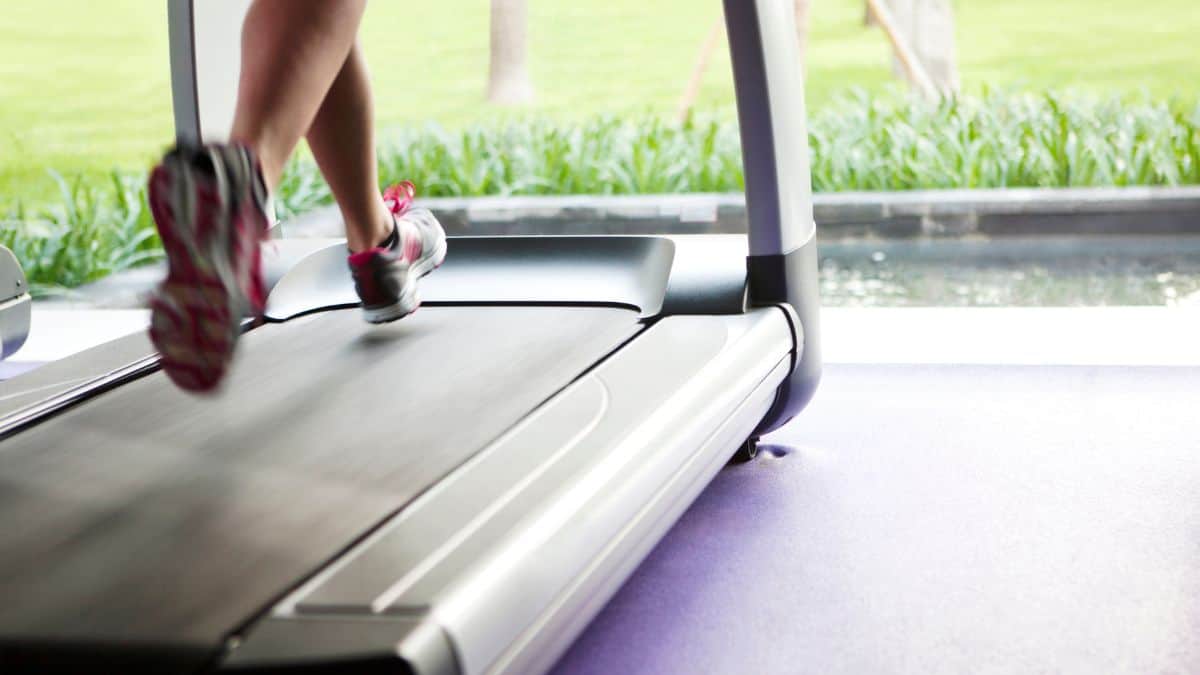What do you think of when you picture a treadmill? Most likely, it’s some combination of working hard, going nowhere, feeling miserable, and wanting to be somewhere else. Similarly, the hedonic treadmill is an effect that creates these feelings but without benefiting your physical health.
As life continues, we have countless opportunities to buy fancier things, visit prettier places, and live more luxurious lives. With each upgrade, our bar for material comforts gets a little higher. However, thanks to the hedonic treadmill, these improvements sabotage our finances while doing little for happiness.
What Is Hedonic Adaptation?
Think of a time in your life when a transition brought you a rush of joy. It could be when you bought your first car, moved into your first apartment or house, or a time you fell in love.
Major life events like these can make us feel ecstatic, but that ecstasy gradually fades, and we eventually return to a relatively stationary level of happiness. As the novelty wanes, these things become part of the regular picture of your life. Somewhere along the way, “your new car” becomes “your car.”
You may still love these things many years later, but the pulse-racing joy you felt while they were new was temporary. This effect is called hedonic adaptation.
While pleasurable new experiences can facilitate happiness, they don’t significantly improve it on their own. Material comforts and new experiences can bring a rush of positive emotions, but people become accustomed to them over time. That’s when they become more familiar, and we revert to a relatively stable level of happiness.
What Is the Hedonic Treadmill?
Over time, your first car degrades and falls out of date. It needs more repairs, the heater doesn’t work, and it’s starting to rust. Something that used to provide happiness now starts to feel unpleasant. So you buy a new car that’s faster, sleeker, and more luxurious.
The new purchase brings a rush of enjoyment. However, due to hedonic adaptation, this too will eventually transition from “your new car” to “your car.” The cycle repeats, returning you to your happiness set point before you once again start to wonder what comes next.
This effect is the hedonic treadmill — a term psychologists use to describe the cycle of pursuing pleasure, adapting to it, and moving on to a new desire.
Hedonic adaptation on its own is not especially harmful. However, once we climb onto the hedonic treadmill, the endless dopamine-fueled pursuit of hedonistic reward can severely harm our financial and mental health.
Lifestyle Creep
When it comes to spending money, the hedonic treadmill also goes by another name: lifestyle creep. The pursuit of happiness primarily through materialism and hedonism leads us to upgrade the things around us gradually:
- Bigger homes
- Fancier cars
- Newer electronics
- Nicer clothing
- Professional services (house cleaners, landscapers, contractors, assistants, etc.)
We call this phenomenon lifestyle creep because it happens slowly, bit by bit, almost entirely unnoticed. Then, after enough years of this pattern, you end up with a lifestyle that costs ten times as much as it used to but doesn’t make you ten times happier.
Even more nefariously, lifestyle creep works like a trap. While upgrading your life with each bonus or raise at work is easy, dialing things back later without creating negative feelings like disappointment and deprivation is pretty challenging.
No matter how much you chase external rewards, you ultimately remain stationary from a happiness perspective. It’s like a regular treadmill, except that you’re spending all your money instead of doing cardio, and it’s hard to say which of the two is worse.
The Hedonic Treadmill’s Effect on Happiness
You cannot reach a lasting sense of contentment while stuck on the hedonic treadmill. It can briefly make you happier, but only until hedonic adaptation takes hold.
Attempts to buy happiness work like the instant gratification you get from sugar. It looks incredibly inviting when you’re hungry and may temporarily feel satisfying. However, the hunger comes back almost immediately because sugar wasn’t what your body actually needed.
Once the novelty wears off, and our brains adapt to a particular life change, day-to-day adversity and negative thoughts return. We once again start to feel discontent, hungry for something new.
That discontentment keeps us running on the treadmill. We continue the search for something better that will bring all the happiness we’ve been chasing. Over time, this may even increase unhappiness by making us feel that we can never reach true contentment.
The Hedonic Treadmill and Your Finances
Over the course of a lifetime, lifestyle creep can devastate your overall financial wellbeing. Each successive lifestyle upgrade brings new, increased costs. Since the hedonic treadmill rarely lets you go backward, your monthly expenses continue to inflate over time.
For many households, each new raise, promotion, or windfall brings new luxuries, bills, and purchases. Like a malignant parasite, lifestyle creep slowly swallows up household resources.
The cumulative impact of this lifestyle inflation can hinder or even cripple your progress on the types of financial goals that contribute to true happiness:
- Reaching basic financial security
- Becoming debt-free
- Saving for a comfortable retirement
- Creating more time freedom and independence
It’s an unfortunate paradox that trying to find happiness on the hedonic treadmill takes us away from the authentic happiness we could be building by stepping off it.
Stepping Off the Hedonic Treadmill
The implications of the hedonic treadmill may appear a bit grim. If pursuing this feeling of happiness only hurts us in the long run, does that mean we must always be mildly unhappy?
Not exactly.
There are many proven ways to improve happiness, but none involve outrunning the hedonic treadmill, gaining external rewards, or buying new things.
At the risk of sounding like a straight-to-TV kids’ movie, a truly happy life comes from within.
Each of us can build and lead a happier life, but not by continuously chasing consumer comforts and upgrading our possessions. Instead, we need to use time-tested keys to happiness to boost our moods and improve our resilience to negative emotions.
Look below for a few techniques that can actually deliver on the hedonic treadmill’s false promises.
Gratitude
“It’s not having what you want, it’s wanting what you’ve got” – Sheryl Crow
The practice of gratitude is the most effective counter to the discontentment that the hedonic treadmill causes.
Everything we own and interact with will cause minor friction and negativity for us from time to time. If we don’t want discontentment to take over, we need to find other ways to be happy than the fleeting spark we feel when things are new.
Practicing mindfulness and learning to be grateful is a fantastic way to savor the positive qualities of your possessions, your surroundings, and your life. With these uplifting associations forefront of mind, you have lasting motivation to push past the day-to-day discomforts and appreciate what you have, rather than chasing after the next improvement.
Minimalism
If there exists a perfect antithesis to the hedonic treadmill, minimalism might be it.
Minimalism is the practice of owning fewer things, notably fewer things you don’t love. This selectiveness allows you to put more time, energy, and money into the things you treasure that make you feel happy.
Minimalists practice decluttering and reducing the things they own. They learn to let go of possessions that serve no functional or personal purpose. One typical result is buying fewer but higher quality items that last longer, work better, and don’t need replacing as often.
Similar to gratitude, minimalism is a terrific way to find more joy in the things you own without any need for the novelty of the hedonic treadmill.
Positive Thinking
Positive thinking is the key to everything from improving subjective experiences to building better relationships. But, of course, there is no better application of the baffling power of positive thinking than its most basic core purpose: helping you lead a happy life.
A positive mindset enables you to find more positive experiences in practically any situation, and it doesn’t require you to spend cash constantly to do so. Plus, the energy you invest in optimistic thinking builds momentum. So the more you choose optimism, the easier and more natural it becomes.
Connection
Happiness research repeatedly shows that human beings experience significantly increased life satisfaction when we connect to others with compassion, empathy, and kindness.
There are countless ways that acts of kindness can improve one’s baseline level of overall happiness. Practically anything you can do to make other people happy will make you feel good, too.
From volunteering and major acts of generosity to simple pleasures like smiling with friends or sharing laughter, helping others and connecting with them is hugely beneficial for your self-esteem and happiness in life.
Choosing Happiness That Lasts
The rewards that that hedonic treadmill gives us are small and fleeting, while its costs are unforgivably high. So it’s time we treat it the way most people treat their regular treadmills — stash it in the basement and forget about it.
The thing that keeps us trapped on the hedonic treadmill is an endless hunt for a kind of happiness that always wears off. Getting off it means putting down some of our more consumerist pursuits in favor of timeless sources of lasting happiness: freedom, positivity, security, contentment with the present moment, and emotional peace.

